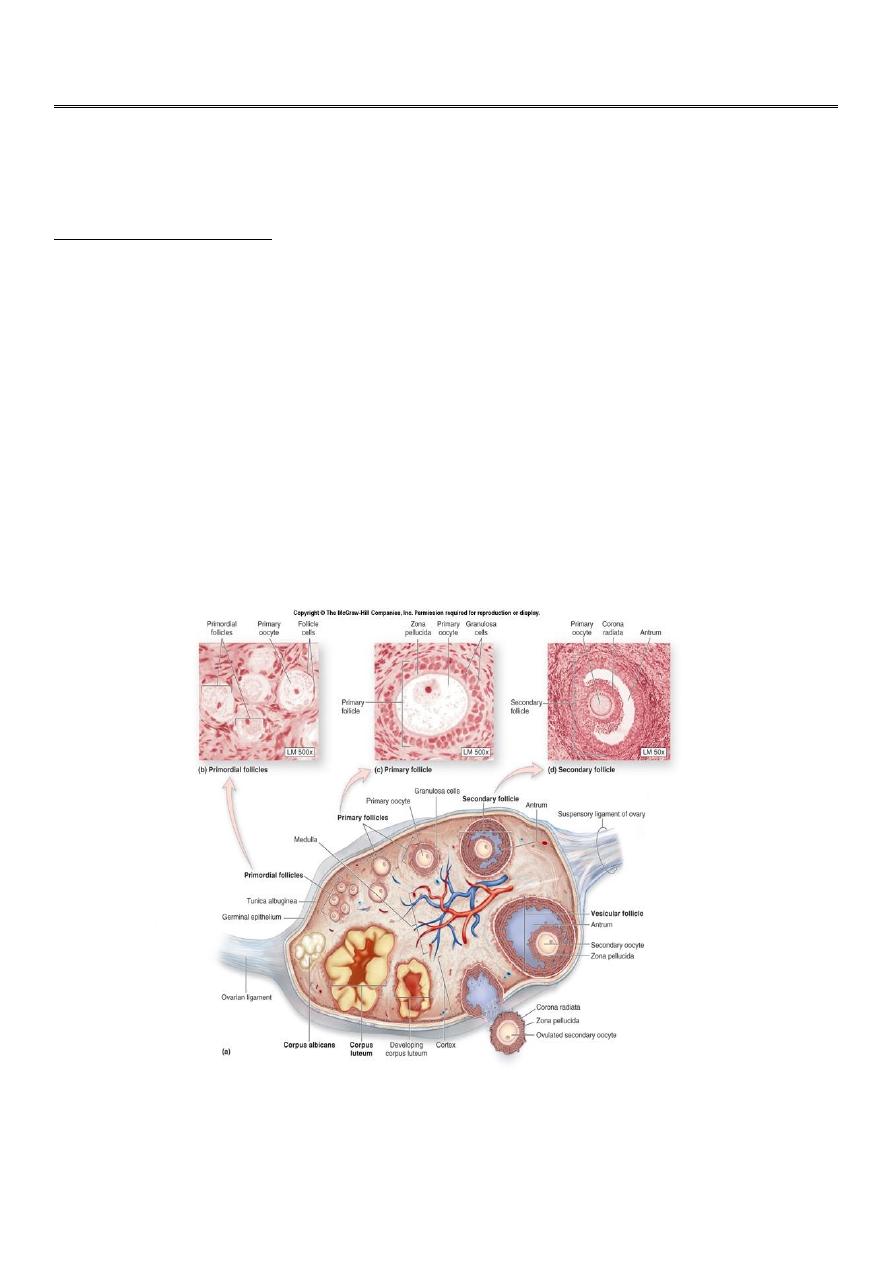
1
Fifth stage
Gynecology
Lec-6
.د
اسماء
13/4/2016
Ovarian cyst
Objectives of this lecture:
1.To learn the type of ovarian mass.
2.To differentiate between ov. Cyst &ov.tumor
3.To know the different type of ov.cyst
4.To learn their management.
Ov. Tumor include:
1. ov. Cyst
2. ov. Neoplasm.
Ov. cyst :
1. physiological cyst.
2.pathological cyst.
Ovarian cyst:
Classification:

2
A.Benign ovarian cyst.
An ovarian cyst is any collection of fluid, surrounded by a very thin wall, within an
ovary. Any ovarian follicle that is larger than about two centimeters is termed an
ovarian cyst. An ovarian cyst can be as small as a pea, or larger than a cantaloupe.
Most ovarian cysts are functional in nature, and harmless (benign)In the US, ovarian
cysts are found in nearly all premenopausal women, and in up to 14.8% of
postmenopausal women.
Ovarian cysts affect women of all ages. They occur most often, however, during a
woman's childbearing years.
Some ovarian cysts cause problems, such as bleeding and pain. Surgery may be
required to remove cysts larger than 5 centimeters in diameter.
Types:
Functional cysts
Some, called functional cysts, or simple cysts, are part of the normal process of
menstruation. They have nothing to do with disease, and can be treated. There are 3
types, Graafian, Luteal, and Hemorrhagic. These types of cysts occur during ovulation.
If the egg is not released, the ovary can fill up with fluid. Usually these types of cysts
will go away after a few period cycles.
Graafian follicle cyst:
One type of simple cyst, which is the most common type of ovarian cyst, is the graafian
follicle cyst, follicular cyst . This type can form when ovulation doesn't occur, and a follicle
doesn't rupture or release its egg but instead grows until it becomes a cyst, or when a
mature follicle involutes (collapses on itself). It usually forms during ovulation, and can
grow to about 6cm (2.3 inches) in diameter
It is thin-walled, lined by one or more layers of granulosa cell, and filled with clear fluid. Its
rupture can create sharp, severe pain on the side of the ovary on which the cyst appears.
This sharp pain (sometimes called mittelschmerz) occurs in the middle of the menstrual
cycle, during ovulation. About a fourth of women with this type of cyst experience pain.
Usually, these cysts produce no symptoms and disappear by themselves within a few
months
Ultrasound is the primary tool used to document the follicular cyst. A pelvic exam will also
aid in the diagnosis if the cyst is large enough to be seen.

3
Corpus luteum cyst:
Another is a corpus luteum cyst (which may rupture about the time of menstruation, and
take up to three months to disappear entirely). This type of functional cyst occurs after an
egg has been released from a follicle. The follicle then becomes a secretory gland that is
known as the corpus luteum. The ruptured follicle begins producing large quantities of
estrogen and progesterone in preparation for conception.
If a pregnancy doesn't occur, the corpus luteum usually breaks down and disappears. It
may, however, fill with fluid or blood, causing the corpus luteum to expand into a cyst, and
stay on the ovary. Usually, this cyst is on only one side, and does not produce any
symptoms.
It can however grow to almost 10cm (4 inches) in diameter and has the potential to bleed
into itself or twist the ovary, causing pelvic or abdominal pain. If it fills with blood, the cyst
may rupture, causing internal bleeding and sudden, sharp pain. The fertility drug
clomiphene citrate (Clomid, Serophene), used to induce ovulation, increases the risk of a
corpus luteum cyst developing after ovulation.
These cysts don't prevent or threaten a resulting pregnancy. Women on birth control pills
usually do not form these cysts; in fact, preventing these cysts is one way the combined pill
works.In contrast, the progesterone-only pill can cause increased frequency of these cysts.
Hemorrhagic cyst:
A third type of functional cyst, which is common, is a Hemorrhagic cyst, which is also called
a blood cyst, hematocele, and hematocyst. It occurs when a very small blood vessel in the
wall of the cyst breaks, and the blood enters the cyst. Abdominal pain on one side of the
body, often the right side, may be present. The bleeding may occur quickly, and rapidly
stretch the covering of the ovary, causing pain. As the blood collects within the ovary, clots
form which can be seen on a sonogram.
Occasionally hemorrhagic cysts can rupture, with blood entering the abdominal cavity. No
blood is seen out of the vagina. If a cyst ruptures, it is usually very painful. Hemorrhagic
cysts that rupture are less common. Most hemorrhagic cysts are self-limiting; some need
surgical intervention. Even if a hemorrhagic cyst ruptures, in many cases it resolves without
surgery.
Patients who don't require surgery will experience pain for 4 - 10 days after, and may
require several days rest. Studies have found that women on tetracycline antibiotics
recover 25% earlier than the majority of patients, a surprising correlation found in 2004.
Sometimes surgery is necessary,such as a laparoscopy that uses small tools inserted
through one or more tiny slits in the abdomen).

4
Endometrioid cyst:
An endometrioma, endometrioid cyst, endometrial cyst, or chocolate cyst is caused by
endometriosis, and formed when a tiny patch of endometrial tissue (the mucous
membrane that makes up the inner layer of the uterine wall) bleeds, sloughs off, becomes
transplanted, and grows and enlarges inside the ovaries. As the blood builds up over
months and years, it turns brown. When it ruptures, the material spills over into the pelvis
and onto the surface of the uterus, bladder, bowel, and the corresponding spaces between.
Treatment for endometriosis can be medical or surgical. Nonsteroidal anti-inflammatory
drugs (NSAIDs) are frequently used first in patients with pelvic pain, particularly if the
diagnosis of endometriosis has not been definitively established. The goal of directed
medical treatment is to achieve an anovulatory state. Typically, this is achieved initially
using hormonal contraception. This can also be accomplished with progestational agents
(i.e., medroxyprogesterone), danazol, gestrinone, or gonadotropin-releasing hormone
agonists (GnRH), as well as other less well-known agents.
These agents are generally used if oral contraceptives and NSAIDs are ineffective. GnRH can
be combined with estrogen and progestogen (add-back therapy) without loss of efficacy
but with fewer hypoestrogenic symptoms. Laparoscopic surgical approaches include
ablation of implants, lysis of adhesions, removal of endometriomas, uterosacral nerve
ablation, and presacral neurectomy. They frequently require surgical removal. Conservative
surgery can be performed to preserve fertility in young patients. Laparoscopic surgery
provides pain relief and improved fertility over diagnostic laparoscopy without surgery.
Definitive surgery is a hysterectomy and bilateral oophorectomy.
B .Pathological cysts:
The incidence of ovarian carcinoma (malignant cancer) is approximately 15 cases per
100,000 women per year.
Other cysts are pathological, such as those found in polycystic ovary syndrome, or those
associated with tumors.
A polycystic-appearing ovary is diagnosed based on its enlarged size — usually twice normal
—with small cysts present around the outside of the ovary. It can be found in "normal"
women, and in women with endocrine disorders. An ultrasound is used to view the ovary in
diagnosing the condition. Polycystic-appearing ovary is different from the polycystic ovarian
syndrome, which includes other symptoms in addition to the presence of ovarian cysts, and
involves metabolic and cardiovascular risks linked to insulin resistance.
These risks include increased glucose tolerance, type 2 diabetes, and high blood pressure.
Polycystic ovarian syndrome is associated with infertility, abnormal bleeding, increased
incidences of pregnancy loss, and pregnancy-related complications. Polycystic ovarian

5
syndrome is extremely common, is thought to occur in 4-7% of women of reproductive age,
and is associated with an increased risk for endometrial cancer. More tests than an
ultrasound alone are required to diagnose polycystic ovarian syndrome.
Symptoms:
1. Some or all of the following symptoms may be present, though it is possible not to
experience any symptoms:
2. Dull aching, or severe, sudden, and sharp pain or discomfort in the lower abdomen
(one or both sides), pelvis, vagina, lower back, or thighs; pain may be constant or
intermittent -- this is the most common symptom
3. Fullness, heaviness, pressure, swelling, or bloating in the abdomen
4. Breast tenderness
5. Pain during or shortly after beginning or end of menstrual period.
6. Irregular periods, or abnormal uterine bleeding or spotting
7. Change in frequency or ease of urination (such as inability to fully empty the bladder),
or difficulty with bowel movements due to pressure on adjacent pelvic anatomy
8. Weight gain
9. Nausea or vomiting
10. Fatigue
11. Infertility
12. Increased level of hair growth
13. Increased facial hair or body hair
14. Headaches in some cases
15. Strange ribs pains, which feel muscular
16. Bloating
17. Occasionally, strange nodules that feel like bruises under the layer of skin
18. Feeling of lumps on the lower abdomen
Treatment:
About 95% of ovarian cysts are benign, meaning they are not cancerous. Treatment
for cysts depends on the size of the cyst and symptoms. For small, asymptomatic
cysts, the wait and see approach with regular check-ups will most likely be
recommended.
Pain caused by ovarian cysts may be treated with:
pain relievers, including acetaminophen (Tylenol), nonsteroidal anti-inflammatory
drugs such as ibuprofen or narcotic pain medicine (by prescription) may help reduce
pelvic pain.NSAIDs usually work best when taken at the first signs of the pain.

6
a warm bath, or heating pad, or hot water bottle applied to the lower abdomen near
the ovaries can relax tense muscles and relieve cramping, lessen discomfort, and
stimulate circulation and healing in the ovaries.Bags of ice covered with towels can
be used alternately as cold treatments to increase local circulation.
chamomile herbal tea (Matricaria recutita) can reduce ovarian cyst pain and soothe
tense muscles.
urinating as soon as the urge presents itself.
avoiding constipation, which does not cause ovarian cysts but may further increase
pelvic discomfort.
in diet, eliminating caffeine and alcohol, reducing sugars, increasing foods rich in
vitamin A and carotenoids (e.g., carrots, tomatoes, and salad greens) and B vitamins
(e.g., whole grains]
combined methods of hormonal contraception such as the combined oral
contraceptive pill -- the hormones in the pills may regulate the menstrual cycle,
prevent the formation of follicles that can turn into cysts, and possibly shrink an
existing cyst.
Also, limiting strenuous activity may reduce the risk of cyst rupture or torsion.
Cysts that persist beyond two or three menstrual cycles, or occur in post-menopausal
women, may indicate more serious disease and should be investigated through
ultrasonography and laparoscopy, especially in cases where family members have
had ovarian cancer. Such cysts may require surgical biopsy. Additionally, a blood test
may be taken before surgery to check for elevated CA-125, a tumor marker, which is
often found in increased levels in ovarian cancer, although it can also be elevated by
other conditions resulting in a large number of false positives.
For more serious cases where cysts are large and persisting, doctors may suggest
surgery. Some surgeries can be performed to successfully remove the cyst(s) without
hurting the ovaries, while others may require removal of one or both ovaries.
